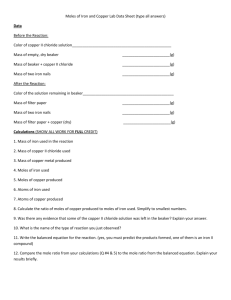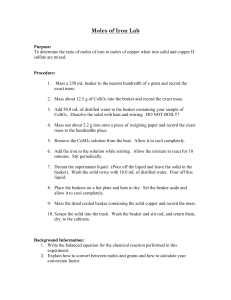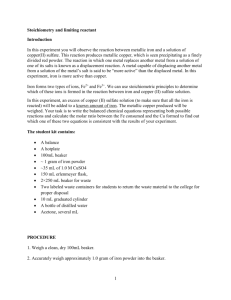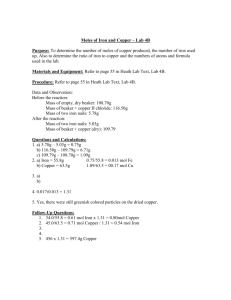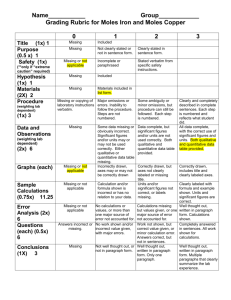STOICHIOMETRY: The Reaction of Iron with Copper
advertisement
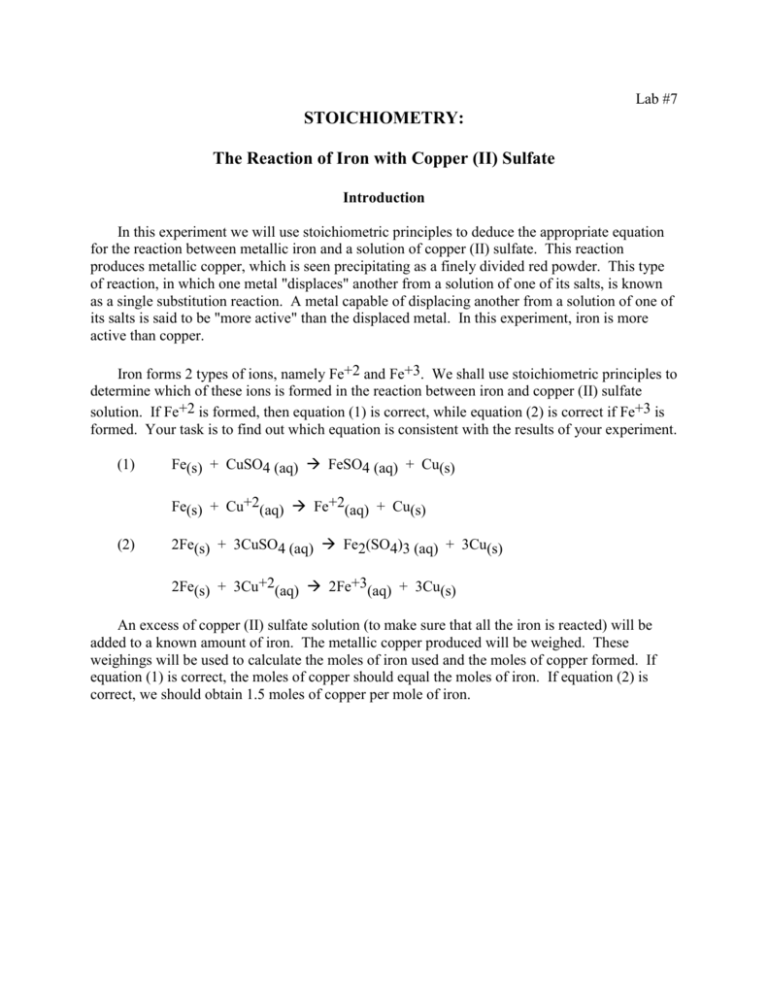
Lab #7 STOICHIOMETRY: The Reaction of Iron with Copper (II) Sulfate Introduction In this experiment we will use stoichiometric principles to deduce the appropriate equation for the reaction between metallic iron and a solution of copper (II) sulfate. This reaction produces metallic copper, which is seen precipitating as a finely divided red powder. This type of reaction, in which one metal "displaces" another from a solution of one of its salts, is known as a single substitution reaction. A metal capable of displacing another from a solution of one of its salts is said to be "more active" than the displaced metal. In this experiment, iron is more active than copper. Iron forms 2 types of ions, namely Fe+2 and Fe+3. We shall use stoichiometric principles to determine which of these ions is formed in the reaction between iron and copper (II) sulfate solution. If Fe+2 is formed, then equation (1) is correct, while equation (2) is correct if Fe+3 is formed. Your task is to find out which equation is consistent with the results of your experiment. (1) Fe(s) + CuSO4 (aq) ! FeSO4 (aq) + Cu(s) Fe(s) + Cu+2(aq) ! Fe+2(aq) + Cu(s) (2) 2Fe(s) + 3CuSO4 (aq) ! Fe2(SO4)3 (aq) + 3Cu(s) 2Fe(s) + 3Cu+2(aq) ! 2Fe+3(aq) + 3Cu(s) An excess of copper (II) sulfate solution (to make sure that all the iron is reacted) will be added to a known amount of iron. The metallic copper produced will be weighed. These weighings will be used to calculate the moles of iron used and the moles of copper formed. If equation (1) is correct, the moles of copper should equal the moles of iron. If equation (2) is correct, we should obtain 1.5 moles of copper per mole of iron. Lab #7 PROCEDURE 1. Only 2 trials have to be reported. 2. Perform the following procedure on two samples simultaneously. 3. Weigh a clean, dry 100 or 250 mL beaker. 4. Accurately weigh approximately 1.00 gram of iron powder into the beaker. Do not exceed 1.00 grams. 5. Measure 30 mL of 1.0 M CuSO4 solution into a graduated cylinder. Pour it into an Erlenmeyer flask, and heat gently to almost boiling. 6. Slowly add the hot CuSO4 solution to the beaker containing the iron powder. Be sure the addition is slow to avoid excess frothing and possible loss of material. It will help to avoid frothing if a wooden applicator stick is placed in the beaker before adding the hot CuSO4 solution. 7. Swirl the flask to insure completeness of reaction. When the reaction has ceased, allow the copper product to settle. Then carefully decant the liquid from the copper, (pour off the liquid and leave the solid behind). You may observe a thin copper colored sheen on the surface of the liquid which does not settle out. You may ignore this. 8. Add about 10 mL of distilled water to the solid copper and swirl to wash any remaining ions from the copper. 9. Decant the wash water from the copper and add 10 more mL of distilled water, swirl and decant again. 10. Now add several mL of acetone (CAUTION: Acetone is very flammable) to the copper. Swirl and allow to stand a few minutes and decant off the acetone. Repeat with a second portion of acetone. Disacrd the acetone in Organic Wastes. The acetone readily dissolves the water and removes it. The acetone is easily removed by gently heating or by using a stream of air since acetone has a low boiling point and readily evaporates. We will use gentle heat. 11. Heat the beaker with the copper product on low heat on a hot plate to evaporate the acetone. Carefully break up any clumps of copper with a spatula, if drying proves difficult. Be sure not to remove any copper from the beaker. 12. When the copper is dry, carefully dry the outside of the beaker and reweigh to find the mass of copper formed. 13. For each run, calculate the moles of iron used and the moles of copper formed. Deduce whether iron goes into solution as Fe+2 or Fe+3. Remember to discard all heavy metal wastes and organic wastes in the appropriate container. Your instructor will provide specific instructions for today's lab. Lab #7 Data and Calculations Name _______________________________________________ Section ____________ Mass of Empty Beaker Mass of Beaker Plus Iron Mass of Iron Used Moles of Iron Used Mass of Beaker Plus Copper Mass of Copper Formed Moles of Copper Formed Ratio: Moles of Cu : Moles of Fe (Divide moles of Cu by moles of Fe) TRIAL 1 __________________________ __________________________ __________________________ __________________________ __________________________ __________________________ __________________________ TRIAL2 ________________________ ________________________ ________________________ ________________________ ________________________ ________________________ ________________________ __________________________ ________________________ Calculation Work Lab #7 Results 1. From your data, which equation (1) or (2) gives the correct stoichiometry for this reaction? Explain your answer. 2. What evidence indicates that a chemical reaction has occurred? 3. State two reasons why you may not recover the theoretical amount of copper in this experiment. Lab #7 Prestudy Name _____________________________________________ Section _____________ The Reaction of Iron with Copper (II) Sulfate Copper can form two possible cations, cuprous (Cu+1) and cupric (Cu+2). When solid copper is reacted with a silver nitrate solution, two reactions are possible, as shown in the following equations: a. AgNO3 (aq) + Cu(s) ! Ag(s) + CuNO3 (aq) Ag+1(aq) + Cu(s) ! Ag(s) + Cu+1(aq) b. 2AgNO3 (aq) + Cu(s) ! 2Ag(s) + Cu(NO3)2 (aq) 2Ag+1(aq) + Cu(s) ! 2Ag(s) + Cu+2(aq) 1.(3 points) How many grams of metallic silver can form from 4.613 g of copper metal according to equation (a)? 2.(3 points) How many grams of metallic silver can form from 4.613 g of copper metal according to equation (b)? 3.(4 points) A student reacts 4.613 grams of copper with a solution containing excess silver nitrate and recovers 6.715 g of silver metal. Which reaction, (a) or (b), most likely occurred in his experiment? Explain your answer completely.
